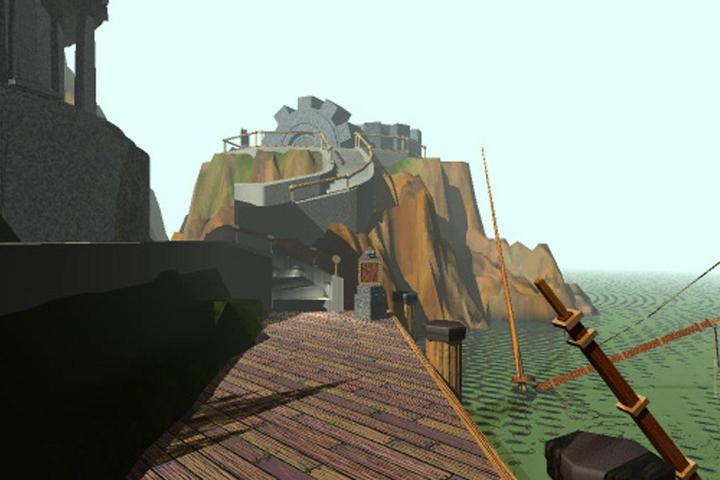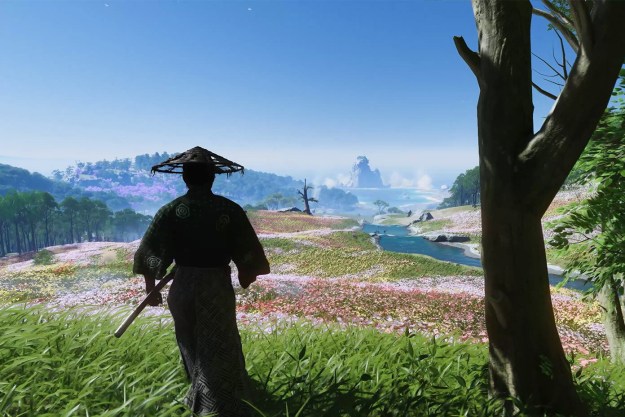
We originally published this interview in March 2013 after a chat with Myst creator Robyn Miller at the Game Developer’s Conference in San Francisco. Myst officially turns 20 today, having released on September 24, 1993. We’re re-sharing our chat with Miller in honor of the game’s lasting achievements and enduring popularity.
It’s a beautiful, clear day and you are standing on a wooden dock with a half-sunken sailing ship to your right and a closed stone door to your left. Off in the distance ahead is a hill topped with two enormous, unmoving metal cogs that appear to be set into the ground. How many of us gamers beheld that same vista in 1993 when brothers Rand and Robyn Miller unleashed Cyan’s Myst upon an unsuspecting world? How How many witnessed it again in one of the many remakes that followed?

Myst was one of the earliest CD-ROM games, and it played a key role in driving consumers to embrace the new technology. The visually rich landscapes that the Miller brothers crafted are instantly memorable, and many of the game’s defining qualities nod to ideas that have since become highly popular development standards. This is a standout effort in the relatively brief history of the medium, and one that scored Robyn Miller, now a full-time filmmaker and producer, the opportunity to take a look back in a post-mortem chat at the 2013 Game Developer’s Conference.
“I never really was a gamer before Myst; I play a lot more games now. And when I play games now it’s with my son.” he tells Digital Trends on the eve of his GDC talk. “I don’t directly play them. I will sit and we’ll go through these worlds. Frankly, I don’t have the ability. I was never gifted with the dexterity to play a lot of these games, but going through the worlds is a real joy.”
“When we made Myst, it was a way of exploring a world,” Miller continues. “That really hadn’t existed for us [as gamers] to do, to explore worlds. After we made Myst, all these people responded to it and I didn’t really understand why they responded to it the way they did. Not until later [when] I got to play other people’s games with my children.”

The Legend of Zelda: Wind Waker was the game where Miller finally “got it.” He was impressed by the scope of the world that unfurled in front of him. It pushed the same buttons that Myst was meant to when the Millers set to work on making it. Computer gaming was in its infancy and text adventures simply didn’t provide the sort of play experience that they wanted to have.
“Zork. We had that. It’s not like we were thinking of it. I’m sure it linked some things,” Miller explains. “That had some of that exploratory sensibility, and it was cool. But I’m a very visual person and I think it just hadn’t captured my attention. Still, it was something. It was a precursor. Myst didn’t come out of nowhere. We’d had those games before.”

Rand and Robyn tried out the pen and paper RPG for themselves, with Rand building a dungeon and assuming the mantle of dungeon master. Only it wasn’t quite Dungeons & Dragons as most fans know it. “He took the rules out and just said, ‘You are yourself here.’ He never rolled the dice for anything. He just described the universe. And it was successful,” Robyn says of his brother’s approach.
“In fact, a part of the universe he created, when we were creating Myst, we actually used. We had created all of these Ages and we were down to the last one [when we asked ourselves] ‘Hey, what about that dungeon you created? Maybe we can apply that somehow.'”
Getting the world set was important, but no moreso than actually giving players things to do there. The thousands of static vistas making up Myst may be memorable, but the play that wraps around them is what drove the game to becoming CD-ROM’s first true killer app. Myst played out across a set of discrete, mostly non-linear puzzles that served to reveal more of both the story and the environment. There was one goal with these during development: keep it grounded.

“We had decided from the beginning that we wanted our puzzles to be as logical as possible, because we wanted them to feel believable. We wanted everything in Myst to be believable,” Miller says. “I’ll give you an example. The spaceship going to the Selenitic Age, it’s very fantastic. But if you sent too much power to the spaceship, the breakers [are tripped]. That’s something that anybody can understand if they know anything about electricity.”
“I kind of feel like [Myst] should be re-made from the ground up,”
At times, the changing attitude led to functional changes on the game side. “When we did Channelwood Age, we had actually designed that differently, but when we built it during production, we re-designed it a bit to make it more believable. It wasn’t through playtesting; it was just through an intuitive sense that we wanted to make this a more believable place. Story-wise of course, but part of that was the gameplay. I think that if it feels less like a puzzle, people tend to enjoy it more. It doesn’t feel like a game anymore. It just feels like you’re in this world and you have a problem to solve.”

“For me, I always had this idea that Riven was the end of the story. I think it’s very cool that there have been so many people that have enjoyed all those [Myst re-releases], but I think as the person who was involved in the creation of the first one, it’s harder for me,” Miller explains. “You create this thing, you have an idea for this thing, and then it veers off in all these other directions.”
“I think it’s amazing that it has done that, and people have been able to enjoy that. It’s theirs now, in a way. A lot of these fans have ownership of this thing. From my perspective, I view it a little differently. In a way it’s kind of hard for me to look at it because I have a different point of view.”
Perhaps this is a product of his current work in film, but Miller looks at the various forms Myst has taken in the 20 years since its release with an attitude that related creative endeavors haven’t gone far enough. Not the post-Riven games, but the Myst remakes specifically. “I kind of feel like it should be re-made from the ground up,” he says.

“I don’t know what that means exactly. Sort of like remaking a movie. What do you do when you remake a movie? You don’t just make it in high-resolution. You don’t re-color it. You kind of step back and say, ‘What doesn’t work in this world and what does work in this world? Let’s start from scratch and totally remake this thing for a new [audience] and completely re-do it.'”
“I feel like games really don’t do narrative very well.”
“I feel like games really don’t do narrative very well. That’s how I look at it, still playing them. I just feel like they don’t do narrative well. Story in games, it’s a branch. You do this, and it goes here; you do this, it goes here [to this other place]. They just branch out everywhere. It gets a little difficult and… a little obtuse,” he says.

Miller’s next project is somewhat like Myst in that it is a work of pure fantasy that remains grounded in a familiar reality. Called The Immortal Augustus Gladstone, it is a fictional documentary in which a film crew discovers an honest-to-goodness vampire living in an abandoned hotel. Miller is the writer and director on the project, which is several years in the making, but it is nearly ready now and looks to be headed for a late-summer 2013 release.
“Our film crew discovers him on YouTube. We follow him around for a few months and, during the course of this, he decides he wants to find one of his descendants. He wants to find family,” Miller says of the movie. “In a way the story has a bit of a magical element or a mythic element to it. It’s been a blast working on it. It’s fun a little bit like Myst in that it’s extremely spontaneous decision-making. Especially during the production. Making creative decisions just like that. Just quick. So we had a blast.
Editors' Recommendations
- Castlevania’s 35th anniversary brings NFTs, not games
- Skyrim celebrates its 10th anniversary with yet another re-release
- The Sims 4 reaches 20 million players ahead of series’ 20th anniversary


